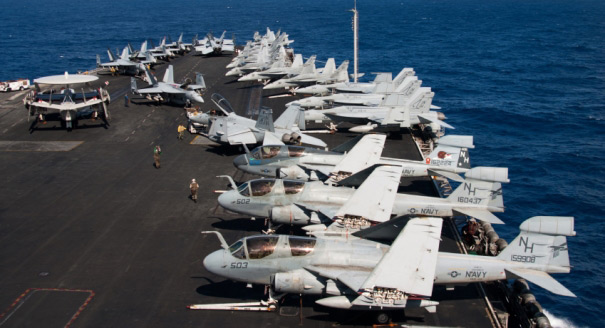This blog post is part of a Carnegie Europe project that takes a critical look at the implications of meeting NATO’s 2 percent defense investment pledge.
*
If all NATO members spent the equivalent of 2 percent of their GDP on defense, the alliance would have fewer critical shortfalls and enhanced credibility in strategic affairs. The politics of NATO’s defense pledge is, in fact, that simple. It is about demonstrating resolve.
In the same vein, the 2 percent promise is about avoiding the fate of the European Union, whose talk on matters of security policy is seen as cheap because its members do not invest. If NATO allies do not find their own strategic policy worth investing in, why should adversaries and rivals take the alliance seriously?
#NATO2percent is about avoiding the fate of the European Union.Tweet This
NATO’s policy is pretty well laid out in terms of military posture, and that posture is explicitly tied to the guidelines in the concluding text of the alliance’s September 2014 summit in Wales. NATO countries should spend more—not randomly, but specifically to meet capability targets and fill shortfalls.
These shortfalls have been glaring for more than a decade, and in 2004 at the alliance’s Istanbul summit they caused NATO heads of state and government to task the North Atlantic Council to draw up input and output indicators to focus attention on the problem.
At around the same time, staff at NATO headquarters noted that the median defense spending for 1991–2003 was 2 percent of GDP—that is, half of the allies spent more than 2 percent, and half spent less. When in 2006 NATO defense ministers approved the 2 percent guideline for the first time, their aim was twofold: to encourage the laggard half of the alliance to improve, and to develop the indicators pinpointed by leaders two years earlier.
Yet the result was that defense spending dropped pretty much everywhere, putting all but three or four allies below the 2 percent bar. That provoked government chiefs in 2014 to make the guideline a matter for the highest political level.
The point remains that the money that NATO members spend is destined for the indicators. There are currently eleven such yardsticks. The guideline of 2 percent of GDP is one of them, while another is that allies should devote 20 percent of their defense expenditure to equipment and research and development.
Then, there are indicators for the implementation of national targets as well as for deployability and sustainability. There are measures for the land, air, and naval forces that each ally deploys, and for the number of slots that each country fills in NATO’s command structure and force structure. Finally, there is an indicator for each ally’s fulfillment of the Immediate Reaction Force, a part of the high-readiness NATO Response Force.
For each of these menu items, NATO ranks each country’s efforts as top, middle, or bottom. This is sensitive information that most allied governments prefer to keep hidden. The Danish government is one of the few to publish the full overview of all eleven indicators.
Were additional money to flow into NATO coffers, it would go mainly to improving allies’ deployability and sustainability. Land, air, and naval forces must train for and have the logistics to support expeditionary operations, and there must be enough units to allow for rotation and therefore sustainability.
This may seem like basic stuff, but both capacities are eroding as budgets decline. By cutting force numbers and capacities, European allies are in particular reducing the sustainability of their forces. NATO’s European members have enough land forces to deploy here and now for short-term emergencies and engagements, but the force levels are not sustainable.
These allies will counter that they are developing reserve forces that can be mobilized for action. Moreover, given the renewed emphasis on territorial defense, such slow “in-place forces” are experiencing a revival.
Observers should not be tricked by the virtues of defense planning make-believe, however. Reserve forces are difficult to handle politically: they are costly to mobilize, considering their effect on society; and they demand political payment up front because to effectively feed into a chain of rotation, they must be mobilized very early on in campaigns.
More money should benefit not only allies’ force capacities but also NATO’s command and control infrastructure. I would define this broadly, including both the intelligence, surveillance, and reconnaissance capabilities that help shape decisions and the command capacity for implementing those decisions (the alliance’s headquarters).
#NATO has cut too deep in its collective command structure.Tweet This
There can be no question that NATO has cut too deep in its collective command structure in this regard. The alliance lacks eyes and ears, the expertise in area studies that standing headquarters can develop, and the simple organizational capacity for managing, say, a high number of air sorties.
This impoverished infrastructure results essentially from the widespread belief that threats are global and dynamic, and hence that there is no need to invest in a regionalized command structure. There is also a U.S.—and French and British—desire to push costs onto junior allies, as the NATO command structure is funded by all allies, but the forces and force headquarters (at the divisional, brigade, and battalion levels) in NATO’s force structure are not.
However, geography matters, as NATO is learning these days, and it is not enough to tout the notion that the mission determines the coalition. Western coalitions depend on deployable and sustainable forces as well as on robust command systems. NATO enables all of this, but only if the allies care to put their money where their mouths are. That is really what the 2 percent guideline is trying to say.
Sten Rynning heads the Center for War Studies at the University of Southern Denmark.










